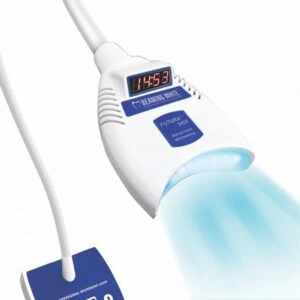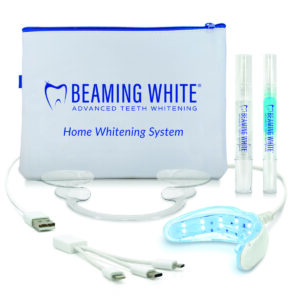Teeth Whitening Lights
Beaming White manufactures its own blue LED bleaching lights, which is in stark contrast to most of our competitors as they are resellers of cheap Chinese teeth whitening lights. We have our own proprietary industrial designs, electronics and software. For this reason, the Futura line of teeth whitening lights and machines is considered the top brand in the cosmetic teeth whitening field.
The Futura 2400 comes with a lifetime warranty, so that should tell you everything you need to know about the quality of the product. Besides the Futura 2400, we do offer one inexpensive Chinese bleaching light that we do not manufacture, the Futura Lite, which only has a one-year warranty.
For best results, use our professional teeth whitening lights with our professional teeth whitening kits.
Professional Teeth Whitening Lights
-

Futura 2400 Professional Teeth Whitening Light
Product Details -

Aluminum Travel Case for Futura 2400
Product Details -

Futura Face LED Light Therapy & Teeth Whitening Machine
Product Details -

Futura Lite
Product Details -

Futura 2400 Clamp-On
Product Details -

Detachable Utility Tray
Product Details -

Futura 2400 Dental
Product Details -

Futura 2400 RFiD Card
Product Details
Lights for Whitening Teeth at Home
Home Whitening Kits with Lights
Teeth Whitening with Bleaching Lights
Teeth whitening using lights has a long and varied history. Beaming White only offers blue LED teeth whitening lights because they are the safest, longest-lasting, and least expensive of all teeth whitening lamps. Below we explain the differences between the different types of teeth whitening machines in case you are interested, but you can see our complete lineup of bleaching lights here. Our best-selling teeth whitening accelerator light is the Futura 2400.
Types of Teeth Whitening Lights:
LED
As the name suggests, these lamps consist of LEDs that emit blue light and range in power from fractions of a watt to a few watts. They emit a cold blue light, which is why they are so safe. The light cannot burn the skin or gums. The wavelength is typically in the range of 430-490 nanometers. This wavelength interacts with different chemical compounds, including but not limited to, hydrogen peroxide. The best bleaching agent for teeth is hydrogen peroxide (H2O2) teeth whitening gel. Because blue LED light works so well with H2O2, and blue LED light is so safe, it is no wonder that today most bleaching lights in the teeth whitening industry are of this type.
PLASMA
Plasma lights are excellent for teeth whitening because they are very powerful, but they are also very expensive. They have other dental uses, namely curing composites quickly and effectively. However, few dentists have one. For teeth whitening, they are definitely overkill unless your dental practice will use it frequently for other procedures, but they are out of the question for non-dentists. They typically have power in the neighborhood of 150W.
LASER
When we say laser, we mean a real dental laser light. These are usually used for drilling or cutting into the teeth if the laser is a strong one, or they are used for performing certain dental procedures, usually surgical in nature, on the soft tissue in the mouth, most commonly the gums or gingivae.
In the past, these lasers could remove pigment out of the tooth by destroying the pigment without using gel. However, that was found to be unsafe. Today, the few dentists that use an actual laser will actually use the same whitening gels that are used with blue LED lights. The big drawback of using a laser to whiten teeth is that it fires a narrow beam, so the dentist needs hold it in front of each tooth and move it very carefully from tooth to tooth, so it’s really not a good choice from a profit perspective for the dentist.
UV
Ultraviolet light was found to activate hydrogen peroxide gel, in other words, to make it react faster, so UV teeth whitening lights became the norm for a few years in the industry. The problem with UV light is that it’s harmful to human beings. Even if the dentist could cover up the outside of the mouth, the inside of the mouth was exposed, especially the part of the gums that was not protected with a gingival barrier. For this reason, as soon as it was found that blue LED light works with hydrogen peroxide bleaching gel just as well as UV light, most manufacturers switched to making blue LED teeth whitening lights, which is where the industry is at today. Blue LED light has a very similar wavelength to UV light.
HALOGEN
Zoom from Discus Dental, and a few other teeth whitening lamp distributors, used halogen bulbs as their light source. The problem with this is that these lights are very powerful and get very hot. Therefore, they could easily burn the skin or other tissues so dentists needed to protect the mouth from getting burned. When they realized that UV or cold blue LED light activated the gel just as well or better, most stopped using this technology in their teeth whitening lights.
Product CATEGORIES
Got Questions?
Ready to Get Started?
To become our TOP PRIORITY, click the call now button or fill out this form.
NOTE: By submitting this form, you agree to receive periodic marketing email messages (from which you may easily unsubscribe) and if you enter your phone number, you agree to receive conversational SMS (text) messages from us (from which you may easily opt-out.)














